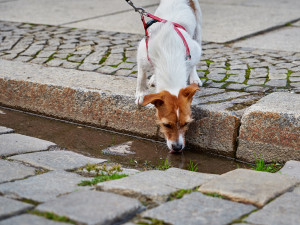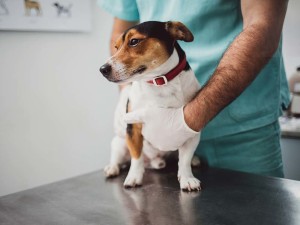Types of Worms In Dogs: How to Detect and Treat Worms In Dogs
Here are the types of worms your pup could get, how you know they have them in the first place and how to get rid of them for good

Share Article
Worms are a generic term for a variety of creepy parasites that can infect your dog, other animals and sometimes humans, too. Many of these parasites live in the intestines, but some can migrate to other parts of the body as well. These worms have all kinds of weird ways to live inside dogs and other animals. Some cause almost no symptoms at all while others can make them very sick. Learn all about these stealthy hitchhikers and how to diagnose and treat them.
How do dogs get worms?
Parasites are transmitted to dogs in a variety of ways. Depending on the worm’s life cycle, they may live in an intermediate host that then comes in contact with dogs or other animals. These intermediate hosts may be prey that they eat, such as mice, snails or fish, or they may be insects such as fleas or mosquitos that transmit parasites when in contact with your pup. Others may be present in the environment and come into contact with your pup that way. Each one is unique in its lifecycle and habits but one thing they have in common is that they are bad news for your pup and you want to steer clear of them.
What are worms?
Worms are a colloquial term for the kinds of parasites that live inside dogs or other animals and need a host in order to survive. Typically, they cannot live outside of a host animal and mooch nutrients and other necessities from their host while causing some degree of damage or inconvenience to their host’s body.
Some of the worms that are seen in dogs include roundworms (very common in the UK), hookworms, whipworms and tapeworms (less common) and heartworm (thankfully not found in the UK, but a risk to any dog travelling overseas). Each of these worms has a different lifecycle with different hosts and different modes of transmission.
How do you know if your dog has worms?
You may or may not be able to detect if your dog has worms because some cause symptoms while others do not. Some may not cause symptoms until the infection is severe. In general, intestinal parasites may cause symptoms related to the digestive tract, including diarrhoea, gas and bloating, vomiting and/or weight loss.
In animals with large amounts of worms, there could even be worms visible in the vomit or segments of worms visible in their poo. Heartworms are different from these kinds of worms since they mainly live in blood vessels in the heart and lungs. This is a parasite that usually will not cause obvious symptomsopens in new tab until the infection is severe. In those cases, the signs may include coughing, shortness of breath, collapse or even death. Thankfully, heartworm is not found in the UK.
Types of worms in dogs
Roundworms
Roundworms are one of the most common intestinal parasites in dogs, especially puppies. This worm’s life cycle includes eggs shed in the environment that are ingested by a host animal. Dogs can be infected, either by eating small mammals that are already infected with larva, ingesting eggs directly from the environment – or most commonly – from their mothers when they are nursing.
Many dogs with roundworms show no signs of the infection, but if they do the common signs are a bloated belly, poor weight gain, diarrhoea and/or vomiting with worms visible in the vomit. This is considered a zoonotic infectionopens in new tab, meaning it can be transmitted to humans. In most cases when humans get roundworms, it is from direct exposure to the eggs in the environment, such as in a sandpit, garden or from ingesting contaminated food. It would be very unusual for a human to get roundworms directly from a dog but is another good reason to practice good hygiene and wash your hands and clean up thoroughly after your dog poos.
Hookworms
Hookworms are appropriately named, given the sharp teeth they use to hook onto the intestines. These worms look like the stuff of nightmares but luckily are only one centimetre long and can be easily treated with the right medications. They infect dogs in a number of creatively horrible ways, including if they eat prey like cockroaches when larvae are directly ingested in the environment, through milk when puppies are nursing from an infected mother or when larva enters through their skin and migrates to the intestines. Dogs with hookworms may have no symptoms at all but can also show gastrointestinal signs, including vomiting, diarrhoea or weight loss.
Because of the sharp teeth they use to attach to the intestines, hookworms cause a lot of damage to the lining of the intestines and this can result in bleeding which may lead to anaemia, blood in the poo or even ulcers. When these worms migrate through the body on their way to the intestines they can also cause respiratory signs like coughing and difficulty breathing or itchy skin. They are also considered to be a zoonotic risk in that people can be infectedopens in new tab by larvae in the environment that enter bare skin. Hookworms are less common in the UK but are prevalent in Europe.
Whipworms
Whipworms are another intestinal parasite of dogs and they have no intermediate hosts. The eggs are shed directly into the environment and are then ingested by other dogs. This worm takes up residence in the large intestine or colon where it causes a lot of inflammation. This can lead to diarrhoea, straining to poo, weight loss, decreased appetite and/or anaemia. Because these eggs are transmitted directly from the environment, it is important to clean up thoroughly after your dog (or other dogs) poo and to make sure dogs are not housed in moist environments where the eggs can survive. Whipworms are relatively rare in the UK.
Tapeworms
Tapeworms may be transmitted in different ways depending on the species, and these worms also establish themselves in the intestines. One species of tapeworm, known as Dipylidium caninum, uses fleas as an intermediate host so dogs tend to become infected by accidentally ingesting fleas. This is common when dogs have a flea infestation because they chew and bite at their skin since the fleas are so itchy, accidentally ingesting some fleas along the way.
The species of tapeworms, known as the Taenia species, use other mammals as intermediate hosts in their life cycle, so dogs are infected if they eat contaminated prey. Tapeworm infections are almost always silent, meaning dogs do not show any symptoms at all; however, occasionally they may have mild gastrointestinal signs and/or itchiness around their anus as they shed segments of the worms. These segments may also be visible around the bum or in the poo and look similar to grains of white rice.
Heartworms
Heartworms are infamous for the risks they pose to dogs. You may have even seen one of those terrifying photos of a dog’s heart filled with spaghetti-like worms in your vet’s office. Thankfully we do not have heartworms in the UK but dogs travelling overseas might be at risk. These worms are different from all the others on this list because they are transmitted by mosquitoes and then migrate through the blood vessels to the heart and lungs.
Heartworm is most risky in places with warm weather all year, where mosquitoes thrive, such as in the southern US and southern Europe. But heartworm infections have been diagnosed in dogs in all 50 states in the US and all dogs are potentially at riskopens in new tab. Early in the infection, there are no symptoms, but in cases that go untreated and the numbers of worms multiply, dogs can develop signs including coughing, difficulty breathing, fatigue, collapse and even death.
How are worms in dogs diagnosed?
There are a number of different ways to diagnose worms and sometimes multiple tests are necessary to confirm a diagnosis.
The physical exam is the first tool your vet will use to look for signs of a parasite infection. Your vet will thoroughly examine your pup from head to toe, listen to their heart and lungs and feel for any abnormalities on their body. Many parasites do not cause visual changes in dogs, but your vet may notice a distended belly, gas-filled intestines, tapeworm segments around the anus or abnormal heart and lung sounds.
Vets will often recommend a faecal exam for dogs showing signs consistent with intestinal parasites; this may also be part of a routine annual check-up. To perform this test, you will need to bring a fresh poo sample to your vet. There are a number of different tests that can be performed to check for parasites and the most common one is called a faecal flotation in which the sample is processed to look for eggs that are shed in the poo.
Different parasite eggs look very distinct so if the eggs are present, the diagnosis is easy. However, due to different life cycles of these worms, eggs are not always present in a single poo sample even if the dog has parasites. It is possible to have a false negative and may be worthwhile to submit additional samples if your dog’s symptoms persist.
Blood tests are the main way to test for heartworm disease in dogs. An in-house antigen SNAP test is usually part of a routine annual check-up and may be performed more frequently if warranted. This is a basic screening test, and if this test comes back positive, additional tests are performed to confirm the diagnosis. Blood tests are not as useful in diagnosing intestinal parasites because they do not test for specific parasites. A dog with intestinal parasites may have certain changes in their blood work such as signs of anaemia or elevated white blood cells called eosinophils, but these findings are not specific to one kind of parasite.
Treatment
For intestinal parasites, treatment is fairly straightforward with the right dewormer combined with a thorough cleaning of the environment. Most dewormers are medications that can be given by mouth, and there are specific drugs that target different parasites, so an accurate diagnosis is important. Because many of these parasites can reinfect their host if they are present in the environment, it is very important to thoroughly clean up all poo, both inside and outside the home. Also, make sure all fabric and hard surfaces are properly disinfected. It is also a good idea to wipe your dog’s hind end and paws after they poo or play outside to reduce the chance of them reinfecting themselves.
Heartworm treatment is more complicated in that the worms are in a vital part of the body and in the process of killing them, they can cause complications for their host. Depending on how long a dog has been infected and the number of worms likely to be present, a vet will consider different treatment strategies. This may include a combination of medications given by mouth with a series of injections given over many months. During treatment, it is very important to restrict your dog’s exercise because they are at higher risk of complications from exerting themselves.
How can you prevent worms in dogs?
There are many effective ways to prevent worms in dogs and you can strategically reduce your dog’s risk of infection with a thorough understanding of how these worms are transmitted. Many monthly preventatives include drugs to prevent fleas and ticks. Preventing fleas has the added benefit of also preventing tapeworm infections from Diplidium caninum. Some of these preventatives also contain medications that will kill intestinal parasites as well, making them a very effective way to keep your pup healthy.
Regular deworming is another strategy that may be useful, depending on your dog’s risks and exposures. Dogs who spend a lot of time outside or live with many other dogs may be more prone to intestinal parasites. They may benefit from routine deworming because they could be spreading the infection to other dogs, even if they don’t have symptoms.
Good hygiene practices are always an excellent way to keep your pup healthy and prevent illness. When it comes to worms, this includes discouraging your dog from eating wild prey or other materials found outside, avoiding contact with sick dogs and wild animals and their poo, cleaning poo up quickly and disinfecting appropriately.
Can you deworm your dog yourself?
If your dog is on a monthly preventative, you may be deworming your pup already without realising it. This is a routine way to prevent most intestinal parasites and heartworms from getting comfy in their new host. If you are concerned that your dog has an active infection, it would not be a good idea to try to deworm them yourself without consulting a vet. This is because different drugs are effective against different parasites and if you don’t know which one is making your dog sick, you may very well use the wrong medication. Over-the-counter medications are not always safe for all dogs and the dosing should be based on your dog’s specific weight to ensure they get the right amount of medication.
Worms are a part of dog life that tend to make people squirm and itch, but knowledge is power when it comes to parasites. The more you know, the better armed you will be to prevent, identify and treat any worms that come your pup’s way.
References:

Dr. Amy Fox, DVM
Amy Fox, DVM is a small animal veterinarian in New York City. A lifelong animal lover, Dr. Fox studied biology in college and then worked as a veterinary nurse before pursuing veterinary school at Cornell University. She has worked in many different settings including shelter medicine, emergency medicine, general practice, and animal cruelty and forensics. She is especially interested in nutrition, preventative medicine and care for senior pets. Dr. Fox also enjoys writing about veterinary medicine and teaching. In her free time she loves to cook, garden, and go for long runs.
Related articles
![Red-haired woman holding sleeping dog in her lap on the bed]()
6 Reasons Your Dog Is Vomiting
And how to help them feel better fast
![Veterinarian examining a dog]()
HGE in Dogs: Causes, Symptoms and Treatment
Certain symptoms could mean your dog is battling a potentially fatal condition called haemorrhagic gastroenteritis (HGE). Here’s everything you need to know
![A black dog with a tilted head looks attentively at the camera while sitting in grass.]()
Is My Dog’s Poo Normal?
From bloody poo to diarrhoea – all your dog’s poo problems explained
![feeding black dog rice water to help relieve diarrhea]()
How to Treat Your Dog’s Diarrhoea
Shudder. It happens to all of us
![Pug dog scooting on a wooden floor in the kitchenFunny dog enjoying scratching his bum on grass at public dog park.]()
Vet Advice and Home Remedies For Dog Scooting
A vet on what to do when ‘anal sacs go bad’
![Dog drinking water from a puddle in the road]()
Giardia In Dogs: Signs, Symptoms and Treatment of This Summer Parasite
If your dog drinks from puddles or splashes around in streams, read this









